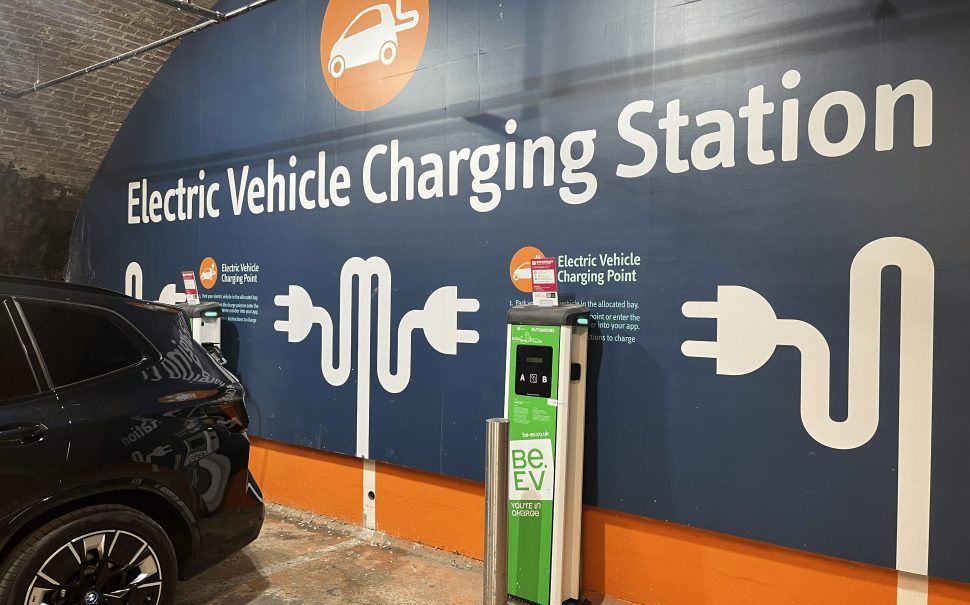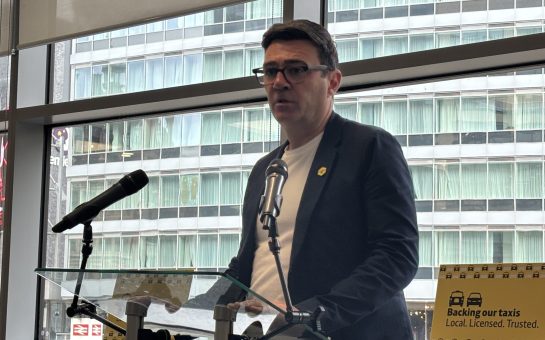Greater Manchester has the lowest number of publicly available electric vehicle (EV) chargers per 100,000 people in England, government data shows.
There are 1171 publicly available EV charging devices in Greater Manchester as of April 2024 according to the Department for Transport, which uses figures from the charging point platform Zapmap.
The metropolitan county has only 40.8 chargers per 100,000 population, less than half of the England average of 91.1.
Transport for Greater Manchester (TfGM)’s ambitious plan, laid out in the 2021 Electric Vehicle Charging Infrastructure Strategy, is to have 3000 publicly available EV chargers by 2025 – meaning the region is still not yet at the half-way mark.
Other areas, like the West Midlands, are performing much better with public chargers, although Manchester does have a high number of home car charger installations compared to other parts of England.
Councils need to ‘get it right’ to meet national electric vehicle targets
Last September the government announced the decision to delay the ban on new diesel and petrol cars from 2030 to 2035.
Gill Nowell, an EV specialist and advocate, with extensive EV and energy industry experience, including eight years consulting on electric vehicle-grid integration projects, is critical of this move.
She said: “I think that gave very mixed messages to consumers and investors as well, which has been potentially quite damaging.”
However, Ms Nowell recognised that new regulations such as the Zero Emission Vehicle mandate are positive steps forwards in the switch to EV and will boost the supply of electric vehicles and bring them to price parity with their petrol or diesel counterparts.
The Zero Emission Vehicle mandate requires 80% of new cars and 70% of new vans sold in Britain to be zero emission by 2030, increasing to 100% by 2035.
She added: “For councils, it will mean that ‘getting it right’ when it comes to charging infrastructure will be increasingly more important because the demand for EVs and therefore chargers will increase.”
Nationally the number of publicly available EV charging devices at all speeds installed in England has risen by 50.6% since April 2023 from 34203 to 51506.
Five Greater Manchester local authorities are in the bottom 30 in England
While Greater Manchester is still miles behind nationally, there are signs that charging in the city-region is finally getting a power-up.
The growth in EV chargers for Greater Manchester exceed the picture nationally with an 86.5% increase in the number of publicly available EV charging devices at all speeds in the past year – with 543 new public chargers.
Yet the numbers indicate how far Greater Manchester still has to go: five out of the ten Greater Manchester local authorities are in the bottom 30 in the country – out of 321.
Tameside has the sixth lowest rate in England with just 16.4 chargers per 100,000 people – and it had the second lowest growth in the region with only eight new public chargers being installed since April 2023.
Although Bolton has the 23rd fewest chargers per person in England, it has seen the largest increase in chargers per person so far this year (65.2%) and the second highest number of new chargers installed since January – with 30 installed so far.
This is due to Bolton Metropolitan Borough Council recently securing £2 million from the Local Electric Vehicle Infrastructure funding (LEVI).
Ms Nowell explained how the funding works.
She said: “The Local Electric Vehicle Infrastructure, or LEVI, fund is money being made available to local authorities from government.
“The aim of the funding is to improve and accelerate the roll out of local chargers, with a focus on on-street charging.”
There are no local authorities in Greater Manchester that match the England average of 91.1 chargers per 100,000, though Trafford is the closest and has the most EV chargers per 100,000 in Greater Manchester with 76.8.
This can be attributed to over 45 public chargers and 18 Tesla superchargers at Trafford Park and the recent opening of Greater Manchester’s largest ultra-rapid EV charging hub at Sale Water Park.
The £1m project saw community-focused charge point operator Be.EV install 22 devices which can charge up to 380 EVs each day.
‘Forward thinking’ Coventry has more public chargers than Greater Manchester combined
Head south on the M6 for a couple hours, and the picture looks very different.
West Midlands (Metropolitan County) has a slightly smaller population than Greater Manchester, yet more than twice the number of public chargers.
And almost three times the number of available public chargers proportionate to the population – with 102.5 chargers per 100,000 people.
Top of the pile in the West Midlands is Coventry, which has more public chargers than the whole of Greater Manchester combined with 1713.
Coventry is also the best local authority for number of EV chargers proportionate to their population outside of London with an impressive 499.0 chargers per 100,000.
EV Charging Infrastructure Consultant – Shamala Gadgil – wrote the city’s first electric vehicle charging infrastructure strategy back in 2017 and works as a consultant to Coventry City Council on innovation projects in transport.
She said: “Coventry is a very forward-thinking authority. None of this would be possible without the visionary cabinet members.
“I don’t believe that the private sector can scale up the charging infrastructure network by themselves, but neither can the public sector. It has to be a collaboration between the two, we have to work together.”
Ms Gadgil regularly seeks additional funding for Coventry City Council to continue to grow their electric vehicle charging infrastructure and won another two funding grants this year which will see a total of 488 additional chargers installed across the city.
Ms Nowell described Ms Gadgil as a “force for good” and there is no doubt that she is the one behind the wheel steering Coventry to success.
Manchester and the North West are racing ahead with home charger installations
Public charging points, however, are not the be-all and end-all. And once you start to consider other metrics, Greater Manchester’s performance doesn’t seem quite so sluggish.
In fact, the region’s home charging figure tells a completely different story.
Electric motorists from Manchester and the North West had the most home EV charge points installed in 2023 according to data from home EV charge point installers Smart Home Charge.
They accounted for 10.71% of the installations in the UK, with the West Midlands following close behind at 10.25%.
EV owner Peter Faulkner, from Heywood, Rochdale said: “For 90% of the time I charge from home.
“For a resident of Manchester, you’re probably not going to charge at these public stations because if you can charge at your house it’s a lot cheaper.”
Charging at home is more cost effective as there is 5% VAT on domestic electricity compared with 20% VAT on public charging.
Peter added: “For people that don’t have home charging it’s more essential that there should be chargers locally, and that’s what’s needed.”
In Greater Manchester, terraced housing and apartments make up almost 45% of the housing stock (Census 2021) and these areas typically have limited access to off-street parking.
Ms Nowell said it’s especially important to make sure there’s plenty of low cost on-street charging for people who can’t charge at home.
And she also described the positive impact EVs can have – not just on the environment, but on your life and your pocket.
“An electric car will brighten up your life!
“It’s a much quieter, calm driving experience; there’s far less to go wrong with an EV too, so maintenance costs are lower.
“If you can mostly charge at home, running costs are super low, it costs me less than £5 to fully charge my car which equates to less than 2p per mile.
“And I love the EV community – there’s lots of support out there.”
Looking to the future – Are Greater Manchester’s plans achievable?
Currently Greater Manchester is 1829 public EV charger installations away from its 2025 target of 3000.
They have installed 136 chargers this year so far.
To reach their target of 3000 EV chargers by the end of 2025 they need to almost triple their current monthly installation rate.
Ms Nowell said: “If we look at the national picture, then in 2023 the number of public charge points across the UK almost doubled, so on that basis Greater Manchester’s plans are achievable if the local authorities have the appropriate support in place to access the government funding that is there specifically to support them in the rollout of public charging infrastructure and especially on street charging infrastructure.
“The important thing is that they take a strategic approach to it and make sure that they are installing the right speed of chargers in the right location in the right numbers and that they are reliable and accessible to all EV drivers.”
A spokesperson for TfGM said:
“Providing better access to charging infrastructure is really important in enabling more people to make the switch to electric vehicles (EVs), in turn improving air quality and helping Greater Manchester meet its ambition to be carbon neutral by 2038.
“Private sector operators are contributing significantly to the expansion EV charge points across the region, supporting the overall growth of charging infrastructure in Greater Manchester.
“In addition, through the Local Electric Vehicle Infrastructure (LEVI) allocation announced earlier this year, TfGM and the 10 Local Authorities are preparing a programme to roll out on-street chargers in areas with lack of off-street parking – more than trebling the current number of publicly available chargers across Greater Manchester.”




